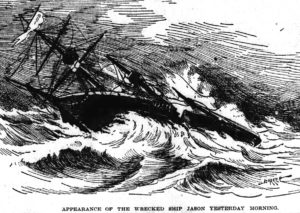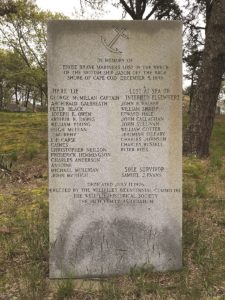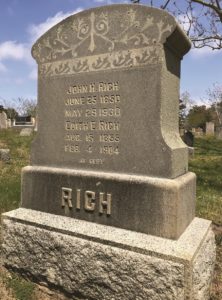The story of the wreck of the British ship Jason in December 1893 is one that serves as a dramatic reminder that the history of Cape Cod is inextricably linked to the mad storms that pummel it.
The Jason was, noted the official report of the United States Life Saving Service, “within only a few hours’ sail of her destination when she encountered the misfortune that left her a hopeless ruin on the beach and swept all but one of her crew to an untimely death.”

Newspapers of the day minced no words with their headlines: “An awful night for seafaring men,” noted one. A “sad spectacle,” “Good Ship Gone,” and “Buried in Breakers,” noted others. One called the ferocious gale in which the Jason had been caught “A Storm of Doom.”
The storm had grown steadily stronger throughout the day, confirming what the lifesaving surfmen had feared: that it would be a night for shipwrecks.
The Jason, built in 1870 and belonging to Greenock, Scotland, was an iron three-masted vessel weighing 1,586 tons. In February 1893, she had sailed, laden with jute, from Calcutta en route to Boston. A few days out, the vessel encountered a cyclone that left her dismasted. A mate was washed overboard. She put in at Mauritius for extensive repairs, after which fine weather had accompanied the passage to Boston — at least until Tuesday morning, Dec. 5, when blinding snow began to fall and the wind howled from the northeast.
Struggling northward, by mid-afternoon the Jason, with Capt. George McMillan having lost his bearings in the thick weather, encountered breakers under its lee. She should have been miles to the windward, giving the arm and fist of Cape Cod wide berth. As darkness closed in, lifesavers from Nauset (Keeper Alonzo Bearse) and Cahoon’s Hollow (Keeper Daniel Cole) followed the Jason’s labored progress, marveling at the vessel’s seaworthiness though certain that in such adverse conditions she would be unable to clear the Truro Highlands. The dire circumstances were communicated to the Pamet Lifesaving Station, whose crew prepared for the worst.

On the beach, surfman Hopkins worked his patrol, as blasts of wind turned the breakers into a cacophony and the sleet into darts that pierced his face. Spotting a ghostly outline two hundred yards from shore, Hopkins could see that the ship, her sails in tatters, had struck the ever-shifting hidden bars. Hurrying back to the station, he informed the crew, who made their way along the beach with their lifesaving apparatus.
The 27 crew members who had sought refuge in the mizzen rigging cheered when they saw the illumination of the surfmen’s bonfire. Assessing the scene, the lifesavers — eventually numbering 20 from four stations — understood that, in such a violent gale, death awaited anyone who might attempt a surfboat rescue. A lifeline, fired from the mortar, found its way to the wreck and successfully lodged on board, but was not located by the crew. Then the iron hull broke in two, the main and mizzen masts toppled, and the crew of the Jason was washed overboard.
As Keeper John H. Rich of the Pamet Station patrolled the beach with his lantern, a young man staggered toward him out of the inky chaos. Having washed ashore clinging to a bale of jute, a delirious 19-year-old Samuel J. Evans was taken to the station. Warmed and nourished, he remained with the lifesavers for several days and was able to tell the story of the wreck and provide some of the names, nationalities, and identifying marks of his shipmates whose bodies, along with the massive cargo of jute, soon began washing ashore.

The official report of the lifesaving service contemplated whether more crew members could have been saved had they sought refuge in the foremast, which was still standing several days after the wreck.
When the sad business of recovering and identifying the dead had been completed, Evans, the sole survivor, reported to the British consul in Boston and took passage home to England.
Twenty-six crewmen were lost that night, many of them with letters from loved ones awaiting their arrival in Boston. Several had family members living in Massachusetts, people who had eagerly anticipated a reunion that was not to be. Seven crew members were lost at sea; the bodies of 19 were recovered. All but one — a young man from Oregon who was found in the ship’s rigging and taken to Provincetown — were placed in the care of undertaker Oliver H. Linnell, who gave each mariner his most conscientious attention. The Wellfleet Cemetery Committee set off two plots in Oak Dale Cemetery, where 14 were interred. Four others were buried elsewhere.
In late January 1894, a letter was received by the lifesaving service from William Evans, Samuel’s father, asking that his sincere and heartfelt gratitude be conveyed to Capt. Rich and “one and all of the gallant crew of the Pamet River Life-Saving Station for their indefatigable and successful endeavors to save the life of our beloved son, S.J. Evans, apprentice of the late ship.”
Historian Edward Rowe Snow added the final chapter to the Jason story, writing in his Storms and Shipwrecks of New England (1946) that Samuel Evans went back to sea shortly after returning to England where, it was said, he fell from his bunk and died.

Capt. John Harrington Rich (1850-1930) was born in Truro to mariner Isaac Rich and Louisa Rich. By 1880, he had joined the lifesaving service and in 1888 became keeper of the Pamet River Station at what is now called Ballston Beach. It was a position he held until 1901, after which he became a successful trader. It was the Rich Family Association that with the Wellfleet Historical Society recognized the crew of the Jason with a prominent memorial dedicated in 1976.
Editor’s note: Our story about the Rich family, “A Gathering of Riches,” was published on Oct. 15, 2020, and our story about O.H. Linnell, “Finding His Marbles,” was published on June 30, 2022. The surfman identified only by his last name, Hopkins, in all other accounts of the Jason tragedy was most likely Reuben Rich Hopkins (1847-1922), based on research by Amy Whorf McGuiggan.



